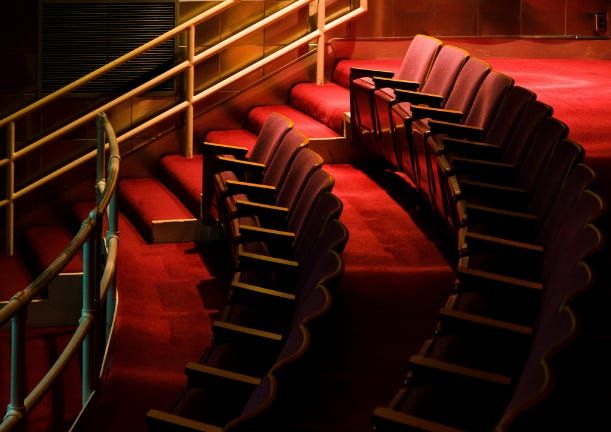In this post I talked about how everyone has situational access support needs that require responsive support. As theatre makers and designers of experiences, we often employ rigid systems that can be taken for granted as being structural requirements. These rigidities are barriers to allowing responsive support, but we can choose to change them.
In traditional theatre, we don’t often address engagement design because the architecture of theatre buildings, and therefore the architecture of typical theatrical production, is very strictly defined by the proscenium arch, ‘theatre style’ seating arrangement where the performance area is separated from the audience area, and the audience are expected to maintain focus on the performance area for a defined amount of time.

Pre- and post-experience are just for booking, travel, feedback. You might be able to engage in some related information about the piece, but there is rarely an opportunity for anything regarded as ‘full’ engagement the day before, or the week after, or a year later.
The seating architecture makes the whole time thing a really difficult structural rigidity to challenge. Once you’re seated, you can’t get out easily without disturbing others. This means a lack of agency around different forms of separation and reconnection that might give people access support.
There are many reasons why someone might need, or just prefer to move between exit & re-entry. (Or between participating & observing, or even between focus & distraction. More of those later.)
Traditional theatre dictates that you can’t separate and then reconnect without the sense that you’ve “missed a bit” (as per the rules of linear narrative), and crucially, without risk of shame.
As I said in my piece in The Stage:
Note: terms such as ‘acceptable’ and ‘reasonable’ are typically defined by common understanding (of which everyone may not be aware), policed by audience members (which could include anyone) and enforced accordingly by venue staff. There is no opportunity for explanation or reasoning at the moment of policing or enforcement. The consequences of being deemed to be in breach are immediate tacit or overt shaming in situ, and may also include untimely ejection from the venue and further public shaming on social media.
The structural rigidity of time frames includes all kinds of challenges to access support needs, like the exact time you need to be ready for the start, and the time you get to depart at the end.
Or how long you can comfortably stay in your seat, and sit still, and fully focus.
Or how long you have to wait before you can next use the toilet, or have a drink (with which to maybe take a painkiller), or otherwise address some discomfort.
Or how long you have during an interval to get to a toilet in the first place, or get to a bar to buy a drink, or otherwise address some discomfort before you have to be back in your seat.

Time frames are a major barrier to access in theatre, but many would argue there’s no way around the limitations they impose. Like Linear narrative, time frames are regarded as an unavoidable part of the structure of traditional theatre.
In the next few posts, I’ll talk about the structural rigidities in creative processes within fourth wall engagement.
Click here for the first post in this series: Barriers to Theatre
Click here for the previous post: Linear Narrative
Click here for the next post: The Fourth Wall
Thanks for joining me on Substack. Subscribing is free, but you can buy me a coffee here if you like. You can also follow my work via The Copenhagen Interpreters’ group on Facebook, and BlueSky / Mastodon / Threads / Instagram / Linktree.



There’s another set of time frames that’s worth considering in conjunction with your post. Theatre is a commercial enterprise and employment contracts look like this: Arrive one hour before Curtain, check that all lights are working, play is 90 minutes, once audience files out, kill the lights, turn on the ghost and you’re free to go. We pay $X for three hours work.
You’ve articulated very well the sort of time-related needs you might have. The flip side is the set of financial needs a show usually has. We can dream of a more audience-accommodating experience - and I do - but it’s bound to cost something